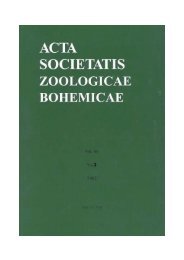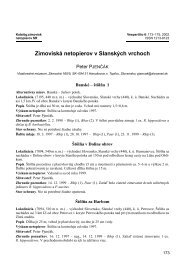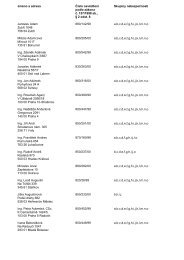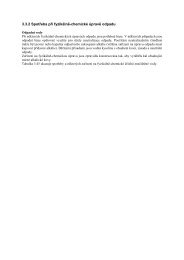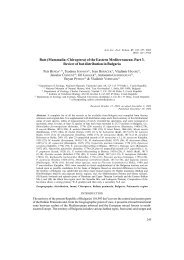You also want an ePaper? Increase the reach of your titles
YUMPU automatically turns print PDFs into web optimized ePapers that Google loves.
Ivo Chlupáč – Vratislav KorduleFig. 5. Plaster cast (plastotype) of Pilocystites primitius Barrande, 1887, spec. Nr. L9049, length 51 mm,Jince. A – original drawing figured by Barrande (1887, pl. 2, fig. 26); B – recent schematic drawing accordingto the plastotype; C – recent photograph of the plastotype.ABCsculpture is developed even insome other Cambrian arthropods,e.g. Hurdia Walcott, 1912,from the Burgess Shale, the remainsof a large tuzoiid arthropoddescribed in this paper, orthe curious Lower CambrianRetifacies Hou-Chen et LU,1989, from the Chengjiang fauna(Hou and Bergström 1997). Asimilar sculpture also occurs inmuch later arthropods, e.g. theenigmatic, late Silurian Dictyocarisand the Lower Carboniferousphyllocarid KulmocarisHahn et Brauckmann, 1977,from the Viséan of Germany(Hahn and Brauckmann 1977).We cannot therefore see anysufficient proof to replace, fornomenclature reasons, the wellestablished and widely used TuzoiaWalcott, 1912, by the olderbut ambiguous Pilocystites Barrande,1887. It is recommendedto use Pilocystites only for thereported plastotype (eventuallyfor the original specimen,should that be found in future).Occurrence: After Barrande(1887) Ginetz, i.e. Jince,evidently the Jince Formation(according to the large “Paradoxides”reported by Barrande),exact locality unknown (for discussionof Barrande’s localitiessee Chlupáč 1999).oblique margin on the left side is interpreted as a fragmentaryposterodorsal margin, all other edges of the remnantbeing secondary. The most characteristic feature – thereticulate sculpture consisting of polygonal reticulae ofunequal size (maximum diameter 5–6 mm) and shape, inwhich pentagonal and hexagonal fields are obvious – fullyagrees with Tuzoia. Also the diminishing reticulae nearthe inferred dorsal and posterodorsal margins are analogousas observed e.g. in our specimen VK41 or in otherspecimens of Tuzoia sp.Although the conspecifity with Tuzoia sp. seems evident,the plastotype cannot in our opinion affect the validityof the generic name Tuzoia Walcott, 1912, even thoughPilocystites Barrande, 1887, has priority. The reason isthat Pilocystites in its original concept (now based exclusivelyon the plastotype) shows no characteristic featuresthat unambiguously demonstrate the identity of both genera:the plastotype does not show the lateral ridge and marginalspines diagnostic of Tuzoia. Similar reticulateLarge tuzoiid arthropod (n. gen.)Pl. III, figs A–C, text-fig. 6Material: The single specimen L36595 from Jince.Description: The specimen is represented by twoseparated, strongly sculptured parts interpreted as remnantsof two very large carapace valves in parallel position,without preserved margins.Each of the valve remnants – the left and the right partsof the fossil – shows an analogous and symmetrical arrangementof sculptural elements. The main median area of both“valves” that occupies most of the surface is flat and markedby a typical sculpture consisting of polygonal reticulae analogousto those of Tuzoia: individual polygons of quadrangular,pentagonal and hexagonal outline form a network ofreticulae 4–7 mm (exceptionally up to 8 mm) in diameter,delimited by narrow ridges. Flat areas with this kind ofreticulation are bordered on both sides (peripheral = outer,median = inner) by areas with clearly different sculpture,consisting of blunt and thickened ridges encircling distinct-172



